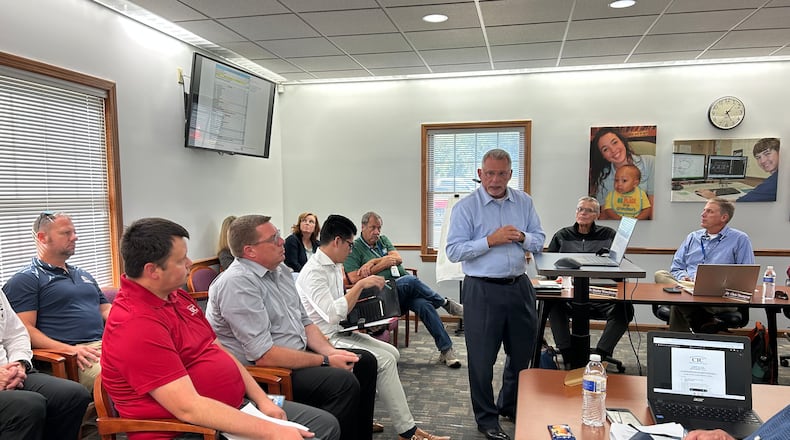Plans are still preliminary, he said, but school officials at Springfield-Clark CTC discussed potential types of renderings, floor plans and site plans.
“There’s a lot of work that still has to be done,” Schorr said.
New taxes funding building
Last year, Clark County voters approved new taxes to fund a $90 million new facility for the CTC.
The 1.4-mill bond and permanent improvement levy had two components, including a 0.94-mill bond issuance with a 37-year duration and a permanent tax levy at 0.46 mills for “permanent improvements” or facility upkeep.
The taxes will generate an estimated total of $4.5 million annually to pay off the long-term bonds, according to the Clark County Auditor’s Office. The cost to a homeowner will be about $49 annually per $100,000 of property value.
The school is expected to start construction on the site expansion in spring 2026.
The total project cost of $89.5 million includes three parts — the state OFCC contribution of about $38.7 million, the CTC’s share of about $24.5 million for the base cost plus the additional $26.2 million from the CTC for items they identified as a need that are not state-fundable.
These items include larger classrooms, larger lab spaces, food service space built to accommodate the number of students, accessibility for all, updated equipment, technology and infrastructure and safety and security considerations, according to CTC officials.
Design process
Schorr recently was looking to get the CTC board’s input on what they like and don’t like related to the designs, he said.
There’s the programming phase, he said, which is the initial design phase, where they talk about spaces, how many and the size of them. Then they go into the schematic design where they take that program and concept plan and try to get everything in its place.
“There’s still going to be some more conversations when we get into the next stage of design development with meeting with your staff, meeting with personnel, of really how we’re going to make those labs work within,” Schorr said.
Building location
The roughly 60-year-old campus has seven existing buildings at 1901 Selma Road. They will be replaced with a single, up-to-date facility that will include additional classroom facilities, equipment and furnishings needed for additional enrollment.
The new facility will be built immediately south of the current administrative building. School officials said it will be far enough away from the existing structures that it won’t interrupt school activities while it is being built.
If the building were to face north, there would be about 28,000 square feet of possible expansion, a separate entrance for parent drop off, students and buses, as well as a separate drive for law enforcement and fire departments.
“We are still working the site, but this is good design where you have separated all that traffic and there’s no overflow,” Schorr said.
Advantages to this layout are future expansion space is maximized, site grading is simplified and high visibility for southbound traffic on Selma Road.
Disadvantages are front entry facing overhead electrical lines and existing garage building/storage buildings that will need to be removed.
The electrical transmission lines have to stay where they are and cannot be put underground, Schorr said. Those transmission lines would be on the other side of the student entrance drive, though, so they would be driving under the high wires, he said.
“In our opinion, it doesn’t really distract from the vision of the building that much as you’re coming into the site through these driveways,” he said.
If the building were to face Selma Road, it would be tougher to get the roads around the wetlands because of the shape of the area, but there would still be separate entrances.
With this layout, the front entry would face Selma Road and be away from the overhead electrical lines.
This plan would limit future expansion space, and site grading will be more challenging.
One issue is staying away from the wetlands that are around where the new facility will be built.
The existing facility will be demolished, except the early childhood building, board office building and maybe some parking lots.
“We are going to come on site with you guys and really talk through what pavements stay, what pavements go, what of these buildings truly could stay,” Schorr said.
Both layouts are constructable because they won’t impact the existing school either way, said Andy Rogers, vice president of Summit Construction. However, the layout facing north does give more future expansion options with the way the buildings are laid out.
“We feel good about our plan moving forward that we’re not going to impact that at all. I don’t think either option has a huge financial impact in our opinion, so we reviewed both, and we feel good about either,” Rogers said.
Building academies and spaces
The current campus is a little more than 182,000 square feet, and the new facility will be 29,000 square feet larger. The school had more than 700 students last school year, but it has also had to turn away more than 700 students over a 10-year span from 2013-23 and another 200 students for the 2024-25 year due to the lack of space.
Schorr said they are trying to create different academies for the new facility to consolidate and combine spaces for certain programs.
“What we’re trying to do is just show you a conceptual floor plan ... and we know we still need to work on this,” he said.
The facility would be broken down into several academies, including:
- Agriculture, which includes courses on forestry, park management and animal science
- Clean energy, including construction and carpentry
- Engineering and manufacturing, including classes on welding, engineering in architecture, applied manufacturing and engineering
- Health sciences and human services, including behavioral health, dental, LPN, exercise therapy and criminal justice
- Transportation, including auto tech, auto collision and specialization
The facility would also include a student commons, media center and staff spaces. The restaurant and cosmetology lab would also have their own separate entrance at the front of the building.
Types of building styles
There are five typical architectural styles for the outside of buildings, including traditional brick, ivy league, public monument, a mix between traditional and contemporary and contemporary forms and materials.
“The ones that you showed initially are more collegial, and from my perspective, I don’t think that works well with technical instruction,” said Board President Jamie Callan.
Board member Keith Culp said, “You can look at it from the outside all day long, it’s the inside that matters.”
Schorr said they’re going to continue working the site plan over the next several weeks — as long as the board approved of the building facing north — and they come back with some options.
“We’re very early in the process. We want to finish our schematic design, but we’ve got a lot more conversation that we need to have ... We got some work to do,” he said.
For more information on the project, visit www.scctc.org/facility-project/project-updates.
About the Author




